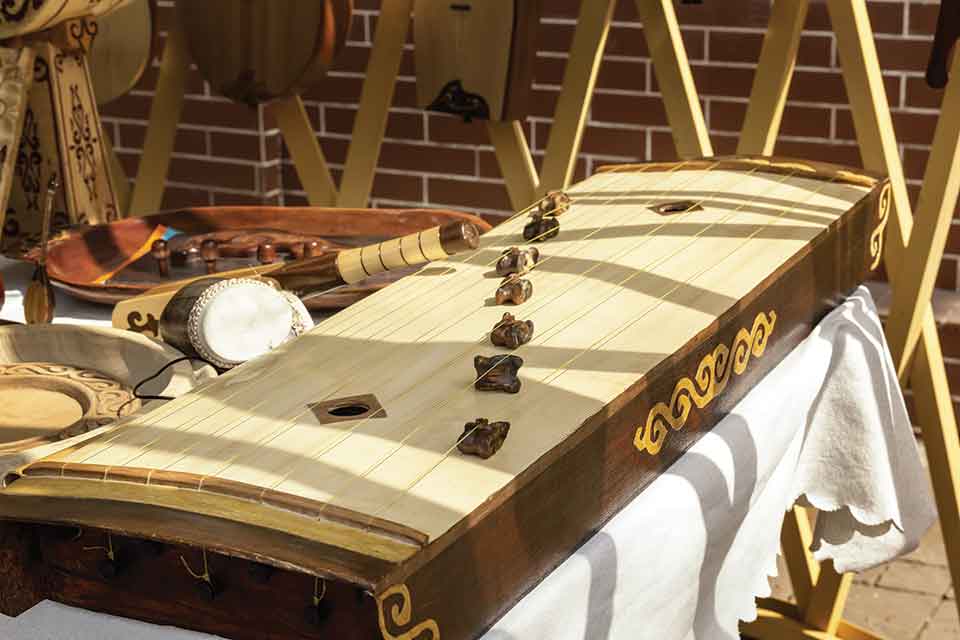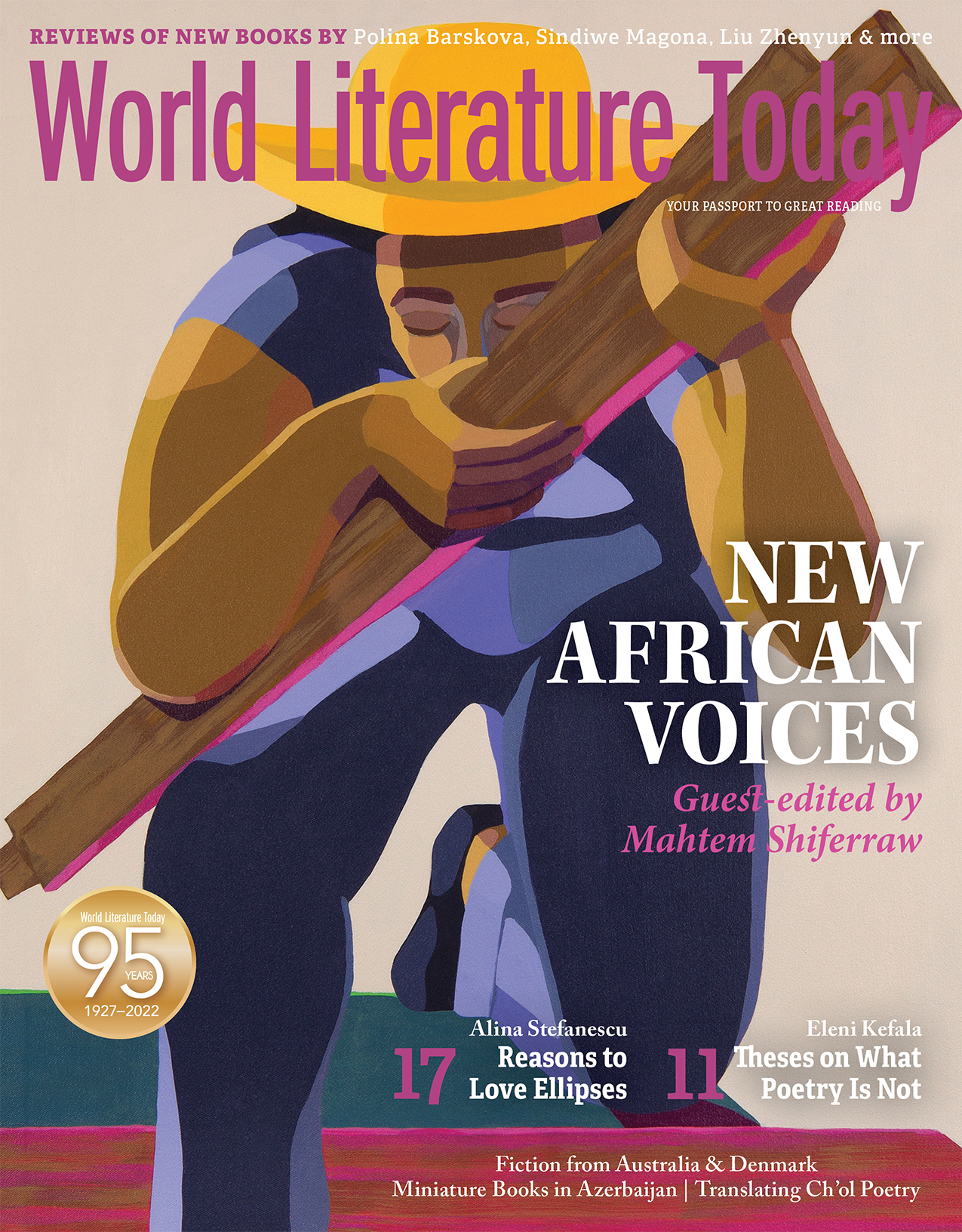A Kazakh “Gold Rush”: How Modern Nomads Sound

Young Kazakh musicians are diversifying Kazakh music and putting an end to the previous generation’s attitude toward traditional music as an untouchable and lifeless relic in a museum, to be loved out of obligation. Blending old and new and using instruments like the electric qobyz and the dombra, these bands are engaging in dozens of contemporary and entirely new styles and trends.
Today’s music scene in Kazakhstan brings to mind the Gold Rush of nineteenth-century America: next to already mining the precious metals of Dimash and Imanbek, there are hundreds of daring musicians digging into a variety of genres like rock, pop, jazz, fusion, techno, indie, and ethno.
The first sprouts of the present musical context emerged thousands of years ago; nomads, for whom oral culture was part of their nature, equated words and music to precious “pieces of fiery lava” (Talasbek Asemkulov). Those musicians who were considered to be saintlike characters, or “the key social factors,” are renowned to this day, among them Korkyt Ata, who was held to be “neither living, nor dead” (ninth and tenth century or earlier), Ketbuga (twelfth century), Asan Kaigy (fourteenth century), Kurmangazy Sagyrbaev (nineteenth century), and Sugur (twentieth century). Striking as it is, many of the elements and principles of this ancient music are at work even today.
Music was at the top of the human-values hierarchy in the culture of nomads: musicians were considered the chosen ones, blessed by the heavens. Then tragedy happened. The complex system of passing on the skills of traditional music—the subtle micro-intonating art, dozens of unique musical instruments, the nontempered musical system, and the art of improvisation— broke after these skills were devalued and stigmatized in the twentieth century during the Soviet era.
Propagandists proclaimed that the Soviet Union had to share the same values and culture throughout its territory, and it must be “national in form and socialist in content.” Kazakh music, akin to a violently broken toy, was buried in the basements of the culture, at times taking a legal appearance in the approved ensembles, and sometimes it dared to blossom and thrive in the hands of young, unofficial musicians.
This music did not vanish in the oppressive regime of the Soviet ideology; it waited, smoldering like coal, then burst into bright flames with the return of oxygen. This oxygen came with independence, gained by Kazakhstan in 1991. The diversity of colors in today’s Kazakh music could be explained via decolonial reflection and through the lens of globalization processes.
Musicians, in turn, are more moved by their unique intonation in music, not by the theoretical comprehension of their art, and they follow a variety of paths to reach their voice.

Traditional Music as the Basis of Pop Music
One of the most sought-after trends of modern Kazakh music is ethno or world music. Artists make music solely or mainly using traditional instruments. This phenomenon first started with the ensemble Turan in 2008. The archaic musical traditions took on a modern, recognized sound, thus rapidly spreading the image of the Kazakh ideal ethno sound around the world.
Turan developed the criteria that became a feature of other bands of this genre:
- each musician of the band plays multiple instruments (up to twenty)
- the overall amount of instruments reaches up to thirty pieces
- there can be throat singing along with the regular vocals
- improvisation is a regular part of a song’s composition
- most of the time the ensemble members are professional musicians and even researchers
Following Turan, new groups have emerged: HasSak, Hazar, Babalar sazy, Steppe Sons, and others. These bands have international fan clubs with millions of members, receive commissions for making soundtracks for TV series and movies, and do tours around the top venues in Europe, Asia, and America. All of the ethno-ensembles are constantly in search of their “gold vein,” reconstructing the forgotten musical instruments, searching for the works of repressed folk singers, all of which are paradoxically attuned to the twenty-first century.

The international evergreen hits proved to be surprisingly organic as covers with the sound of Kazakh instruments. If you don’t watch the video and only listen to “Bye Bye Blackbird” (R. Henderson & M. Dixon), covered by the Steppe Sons, you might mistake the kobyz—a bowed Kazakh instrument (according to Daniel H. Chitwood, one of the predecessors of the violin)—or the dombra—a two-stringed plucked instrument—to be authentic European instruments. Give it a try!
The international evergreen hits proved to be surprisingly organic as covers with the sound of Kazakh instruments.
The prefix “ethno” serves as an identity marker for dozens of trends in Kazakh popular music: ethno-jazz (The Magic of Nomads), ethno-rock (Tigrahaud), neo-ethno-folk (Arkayim), ethno-pop (Erlan Baybazarov, Ja-Ja-Band). This is a way to manifest their style and to highlight the ethnic element of the sound.
These young musicians put an end to the previous generation’s attitude toward traditional music as an untouchable and lifeless relic in a museum to be loved out of obligation. The archaic Kazakh genres Kyi (instrumental piece), Zhyr (epic tale), and An (a song) are now merely the source of inspiration or a musical DNA for today’s musicians. Such freedom provokes emphatic discussions both in academic circles of professional musicians and among audiences. What are the features of this freedom?
Freedom Brings Experimentation

Aspiring to bring the new sound to big venues has led musicians to the necessity of improving their musical instruments. The most vivid example is the band Aldaspan, which plays rock music by electric dombra.
The band’s name translates as “Big Saber,” widening at its end; the aldaspan was one of the primary weapons the Turks used to fight against heavy cavalry and is often mentioned in warrior epic tales. The musicians worked for a long time on developing the electric dombra together with the musical masters of Almaty and Moscow. The first electric dombra was made in 2010; it both preserved the archaic sound and timbre of the acoustic two-stringed dombra and had the drive and technical features of the modern electric guitar. Made of solid wood, the electric dombra didn’t suffer a dramatic change, becoming only a little flatter in shape. At the moment, the band also uses bass electric dombra, rhythm electric dombra, and drums. This resembles the classics of the first rock bands (if we equate electric dombra to the electric guitar). Thanks to Aldaspan, the tunes and elements of ancient Kazakh pieces have acquired a provocative new power and protest-like quality in their sound.

Getting her inspiration from successful experimentation with the dombra, Layla Tazhibayeva (the leader of the Layla-Qobyz band) has followed this experience with another Kazakh instrument: the qobyz (kobyz), the main tool of Kazakh shamans and storytellers. Her electric qobyz was made in 2019; it resembles the original instrument only with its timbre and outlines. The repertoire of Layla-Qobyz consists primarily of arrangements of Kazakh music and covers of songs by Queen, Aerosmith, Nirvana, and Led Zeppelin. One of the most provocative bands, Layla-Qobyz creates extravagant appearances, dramatically changing the sound and structure of traditional kyis.
The traditional instrument zhetygen was also incorporated into the same experiment; a Kazakh plucked instrument, it resembles the Russian gusli, or flat harp, and has seven to twenty-three strings. The electric zhetygen is a feature of the rock band Shapagat.
Another instrument that gained unexpected popularity is considered one of the simplest ones in many Kazakh folk traditions: the sybyzgy, or type of longitudinal flute. It used to be made of a specific kind of reed plant and had three to four finger holes. Modern musicians make sybyzgy using metal or plastic and increase the number of finger holes depending on the composition. Among such artists is Anuar Issaev from the Tigrahaud rock band. An archaeologist by training, Issaev works as a schoolteacher, but his true passion lies in rock music and sybyzgy. Once he had tried out all of the ready-made models, he realized he was not happy with the quality and began making his own instruments.
Besides the construction of the instruments, these experiments also involve performance techniques. This implies the migration of performance techniques from one instrument to another and the invention of radically new ways of extracting sound. This tendency—the so-called extended techniques—is present worldwide in twentieth- and twenty-first-century academic music. The nontempered tuning system of most Kazakh instruments and genetic inclination toward improvisation has become fertile ground for creating new timbres and compositions.

Globalization: Inevitability and a Source for Creativity
The young generation of Kazakh musicians has deliberately stepped away from the Soviet past of the country. They relate much more to American or European musical culture than, for example, the Russian one. If we look at the language distribution of the songs, this would be the ranking: (1) Kazakh, (2) English, (3) Russian.
It’s no accident that, besides diverse cover bands, there is a “Kazakh Soul Man” in Almaty, Zhenis Nurgali; the only appropriate way of communication, he says, is to sing and play soul. When interviewed, Kazakh musicians often cite Charlie Parker, the Beatles, Stevie Wonder, Bill Evans, Miles Davis, Herbie Hancock, John Coltrane, Michael Jackson, Kurt Cobain, Amy Winehouse, Sting, Lorn, and Burial as their musical idols. This list is typical for the musicians of the twenty-first century, independent of their location.
At the moment, Kazakh music does not escape the mimicking of various styles. For example, the Ninety One band is a direct copy of K-pop. With their provocative appearance and behavior, numerous scandals and meticulous management have made Ninety One one of the top commercial projects of the country.
Rap and hip-hop are perceived by Kazakhs as something native and natural. The popularity of these particular genres may be attributed to the long-standing culture of Kazakh oral art. For many centuries, music and poetry were the main and only modalities of art in the nomadic communities. Kazakhs also have a similar genre, called terme, based on recitative poetry. The leaders of this trend are Scriptonite (Adil Jalelov, who works in Moscow), Irina Kairatovna, Truwer, SHIZA, HiRoSima (Bekbolat Kaidarov), Da Gudda Jazz, and others. These bands cover social themes, love, relationships, everyday life, and the dreams of youth. The poignancy of the lyrics embeds them into the hearts of contemporaries; for example, “You smell like love / You are madness at first sight” (Scriptonite’s “Cosmos”).
The Protests of Musical Youth
In April 2019, after several decades of heading the country, the first president resigned. The second president in the country’s history, Kassym-Jomart Tokayev, announced that he was changing the capital city’s name, naming it after the first president: the former Astana is now called Nur-Sultan. This has triggered a wave of protests across the country. Furthermore, this situation stirred the voice of musicians who used to be convinced that music and politics are incompatible. A girl’s tender voice in a quickly made video clip gained millions of views with its hopeless and melancholic tune from Opia:
My Elbasy, set me free from this “paradise”
My people will never rise,
I don’t know the gray steppes land
I am dying here in Nur-Sultan
Block the internet, what if I publish it
Arrest me, I should not be singing it
I will have ten children and name them all Nursultan,
Let them rule the Nur-Otan.
Opia’s style is post-punk; the band represents one of the trends of the underground. Within days, their song became a hymn for activists protesting against the renaming of the capital city; their concerts started getting canceled by organizers due to the fear of being persecuted. Independent musicians then started uniting into communities, sharing their views and musical tastes; thus the union “Qazaq Indie” emerged, followed by commercial projects like OYU on YouTube. The musicians started appearing on state TV, and the ӘНДІGROUND TV Project became well known. The name of the project is a play on the English word underground and the Kazakh word әнді (song or vocal).
The strict lockdown and the pandemic conditions became the context for the popularity of the song “5000.”
The strict lockdown and pandemic conditions became the context for the popularity of the song “5000,” followed by the rest of Irina Kairatovna’s work. The name of the song alludes to the minimal bribe in Kazakhstan. The video clip itself was acclaimed as the “most politically provoking video of 2020.” In the video, you can see the faces of Kazakh politicians who were repressed in the 1930s, common nomads, and Soviet ideologues. One of the video characters is a government official, shown holding an oil pipe in his hands. The pipe, being packed with money, symbolizes the corruptness of the oil industry. Moments later, the official presents his son a toy looking like a project that was never brought to life—the light-rail transport (LRT) in which over $300 million had been invested. The clip illustrates the indifference of a society blinded by propaganda clips about the ever-prospering Kazakhstan. The culmination of the video is a falling body shot by fireworks celebrating the first president’s anniversary. This fireworks display, akin to the “Feast in the Time of Plague,” had indeed taken place right when the country was overwhelmed by panic, a lack of medication, and high fatality rates due to Covid in July 2020. Everyone watched the video: officials, businessmen, youth, and the opposition.
Kuanysh Beisekov, who produces all the videos for Irina Kairatovna, compares the mentality of today’s Kazakhstanis to a fifteen-year-old teenage girl—with braces, glasses, and zits—who is always looking for affirmation and validation from her elder peers (i.e., the developed countries). This idea is fully supported by the examples of internationally renowned Dimash and Imanbek.
Dimash and Imanbek: What Neither the World nor Kazakhstan Saw Coming
Dimash, a young singer with a unique vocal range and gift, has conquered the whole world. Someone from the United States, Germany, Japan, or Canada may have never heard of Kazakhstan, but they most likely have heard of Dimash. Dimash’s ethnic identity grows more and more prominent over time: a lot of Kazakh folk tunes and themes are in his repertoire, and his stage costumes often contain national ornaments. People in Kazakhstan, in turn, proudly watch the growth of the international army of Dimash fans. But this authentic and outstanding artist was not renowned in his own country until he achieved a stunning success at the Chinese “Singer 2017” competition. Before then, he had been criticized in Kazakhstan, and his tours barely made a splash. But following “Singer 2017,” Dimash’s national awards, titles, adoration, and financial support surged.
Imanbek, who won a Grammy award this year, faced similar conditions. A provincial twenty-year-old, Imanbek speaks words that matter to each Kazakhstani. When a popular show host asked him, “Dude, who are you?” he smiled and replied, “I am a Kazakh.” Professional musicians in Kazakhstan attribute his success to mere luck, while students of art institutions are analyzing his case and producing their own covers of Imanbek’s most famous remixes.
I spoke to dozens of young bands; all of them confess that it is way easier for them to perform in Europe or the US than in Kazakhstan.
Such cases as Imanbek and Dimash, now called the “Kazakh Phenomenon,” are typical for Kazakhstan’s “way to success.” To this day, the country does not dare to believe in an unknown artist, band, or talented DJ unless they get global recognition. This inferiority complex forces young musicians to pursue their happiness in Moscow, New York, Beijing, or Berlin. I spoke to dozens of young bands; all of them confess that it is way easier for them to perform in Europe or the US than in Kazakhstan. The state initiatives of support for cultural and creative fields get misplaced or dissolved in the routine life of state philharmonic and other ensembles.
Kazakhs are truly musical people. The young generation of Kazakh musicians today does not expect support from the state; they prefer their own individualism in dozens of contemporary and entirely new styles and trends. They have much to offer the world. Nobody knows if the Kazakh gold rush will bring the blossoming of “new worlds” or if it will result in “ghost towns.” This depends on a variety of factors. I hope that the potential of this generation of Kazakh musicians will not get lost in the noise and speed of our time but will instead get integrated into global culture.
Almaty, Kazakhstan












